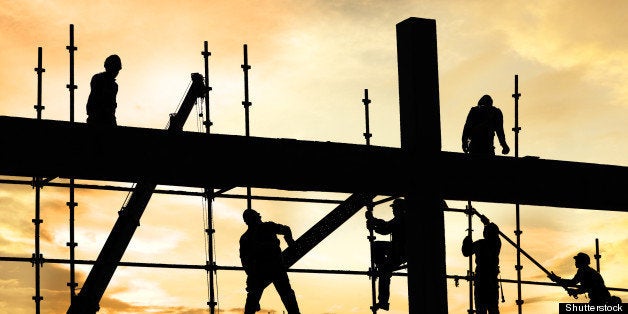
This post was co-authored with Richard Baron, Chairman and Chief Executive Officer of McCormack Baron Salazar in St. Louis, Missouri.
Fixing a city's outdated sewer system is not normally thought of as a way to fight poverty -- but it should be.
All over the country, cities are preparing to put billions of dollars into much-needed upgrades to aging and outdated water and sewer systems. The Environmental Protection Agency estimates that it will take $632 billion to maintain and update the nation's water systems between 2007 and 2027.
These large investments in infrastructure present local leaders with a tremendous opportunity to connect those struggling to get by -- particularly those within low-income communities and communities of color -- to the thousands of quality jobs that these public works projects will create.
In St. Louis, the impending $4.7 billion renovation of the city's stormwater system presents just such an opportunity. While the cost of these renovations for taxpayers has made headlines of late, there's been little discussion of the positive impact this project could have for the local economy. In a city where 27 percent of its citizens currently live below the poverty line, using this project to link disadvantaged communities to the family-supporting wages, employee benefits, and work experience these jobs provide would be transformative, not only for these communities, but for St. Louis' economy as a whole. By bringing the needs of local communities into the project design, the city could extend the benefits of these system upgrades far beyond stormwater management.
This is not a pipe dream; many cities have already seized opportunities like this in visionary ways.
Washington, D.C. is a perfect example. Between 2015 and 2025, DC Water's capital projects will infuse $13.1 billion into the regional economy, supporting the creation of 70,900 jobs over the next decade. Through their DC Water Works
City leaders can also use public works projects to bolster small, locally-owned businesses. For example, the Milwaukee Metropolitan Sewerage District (MMSD) developed a Workforce and Business Development Program to connect small businesses and those owned by women and people of color to the resources they need to compete for and perform on District and City capital projects. Through technical and managerial training, customized coaching, and hiring incentives, this program helped 26 such businesses win 119 District contracts worth $5.4 million between 2005 and 2012.
Other water utilities have had success with workforce innovations that target disadvantaged workers. For example, the San Francisco Public Utilities Commission (SFPUC) forged formal partnerships with the Sheriff's Department and The Garden Project, a local nonprofit, to employ low-income, at-risk youth and ex-offenders for watershed maintenance on vast SFPUC lands. This creates a win-win situation: participants receive wages and important work experience and the city's utilities meet their maintenance needs.
In addition to specific programs, there are many simple changes to hiring practices that utilities can make to ensure that all qualified residents can connect to public works jobs. For example, simplifying job application processes to make them more easily understandable and reviewing job prerequisites for relevance (e.g., not requiring a driver's license for positions that do not require driving). Additionally, efforts should be made to assemble interview panels and recruitment teams that are diverse and reflective of the communities where these projects are taking place.
These workforce development initiatives can also be supplemented with broader community investments. In California, the San Francisco Public Utilities Commission (SFPUC) has pioneered a "Community Benefits" policy that requires large contracts (over $5 million) to include "good neighbor" provisions that give back to communities affected by SFPUC operations. As a result, SFPUC contractors have made commitments to schools, small businesses, and local nonprofits, providing volunteer hours, in-kind donations, and financial contributions. Examples of benefits include scholarships, solar installations for low-income households, and technical assistance for minority- and women-owned businesses.
As St. Louis and other cities make large infrastructure investments, local leaders and policymakers face an immense opportunity to maximize their benefits, strengthening both the physical and economic vitality of their community. A few cities have paved the way, delivering quality jobs and career pathways to those who need it the most. Now it's time for St. Louis to do the same.
